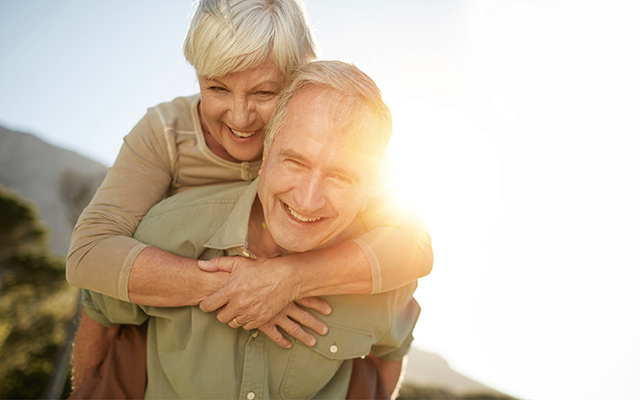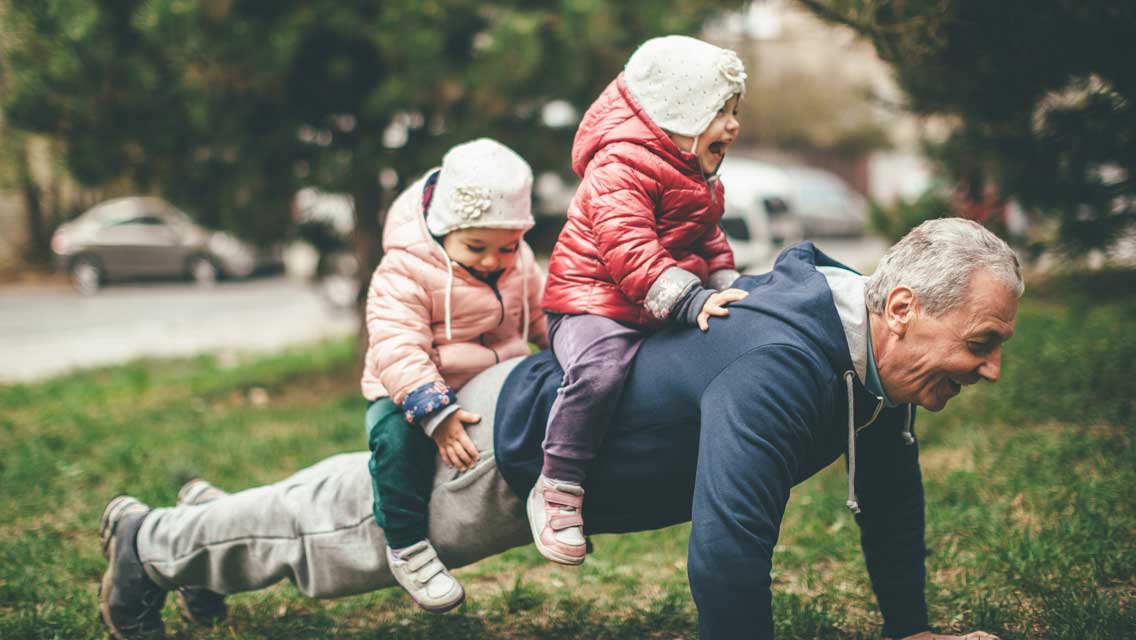“When I am an old woman, I shall wear purple.” So begins Jenny Joseph’s famous 1961 poem about how she intends to buck societal mores by spending her golden years wearing bold colors and doing outlandish things like sipping brandy and sitting down on the pavement when she’s tired. A good sentiment, to be sure, and one that today’s crop of older adults are making good on in their own way: Think silver-haired dynamos in moisture-wicking athletic wear, doing shots of wheat grass, biking to the gym, signing up for triathlons.
Forget frail and meek. Today’s 50-plus crowd is redefining the whole concept of aging and making a passionate and unprecedented commitment to health and fitness. In fact, baby boomers currently represent the fastest-growing segment of gym members. More and more, these activity-loving boomers are rejecting traditional fun-in-the-sun beach holidays in favor of adventure vacations where they can white-water raft, kayak or attend fitness boot camps. These days, it seems, you’re as likely to meet a boomer in a Bikram yoga class as you would at a bingo game.
We’ve Come a Long Way, Baby
So what’s changed? For one thing, we’re living longer. “In 1900, at the turn of the century, life expectancy was 47 years, and now it’s about 82 years,” says Richard Leider, coauthor of Claiming Your Place at the Fire: Living the Second Half of Your Life on Purpose. “There is a greater awareness when it comes to aging and fitness because we now have these bonus years.”
These days, aging is no longer about accepting limitations and degeneration. It’s about embracing life, taking up new pursuits, enjoying our health and fitness, and safeguarding them for an extended future. Today, many older people are using their “bonus years” to defy convention, engaging in activities traditionally associated with the younger set, from having babies to starting new businesses to learning how to snowboard.
In addition to longevity, Leider says, today’s generation of active boomers and retirees isn’t much interested in a traditional retirement. “The old model of retirement has basically been retired,” he says. “Those 50 and older don’t want retirement as it used to be portrayed, with their feet up on the porch. Now people are reinventing themselves all along the way, with a combination of work and leisure, and so in order to remain vital they need to be conscientious on all fronts – mind, body and spirit.”
Today’s older populations are forging a new model of fitness based on overall well-being – one that allows them to keep up with their active and full lifestyles and also stay true to their values of self-determination and independence.
Today’s older populations, many experts agree, are forging a new model of fitness based on overall well-being – one that allows them to keep up with their active and full lifestyles and also stay true to their values of self-determination and independence.
Our values around physical fitness naturally shift with age, says Richard Cotton, MA, chief exercise physiologist with www.myexerciseplan.com and a spokesperson for the American Council on Exercise. Younger people, he notes, tend to place a greater emphasis on working out for the benefit of looking good, whereas the older set has begun to view working out with a wider lens – a whole-person perspective that focuses more on the feeling of health and vitality.
“The popular viewpoints on aging have definitely changed,” says Cindy Joseph, 55, a popular Ford model whose silver-haired image regularly graces J. Jill catalogs. “Our generation questioned everything – the government, the war, taxes, lifestyles, religion. We had to find a new life for ourselves because the examples we were given didn’t make sense to us. And, through our experiments, we’ve discovered that a lot of things that we were told are not true, especially when it comes to health and well-being.”
A devoted raw-foodist, Joseph indulges in a variety of exercise, from archery to belly dancing to walking to working out with a trainer. Her main goals? To have fun and to be healthy and fit. “I think it’s beneficial to be motivated by fun, instead of fear, when it comes to exercise,” she says.
Joseph’s own metamorphosis began about a decade ago, when she started to relax more about aging, trust herself and live her life according to what pleases her. Eight years ago, she even stopped coloring her gray hair. What did she learn during this transformational time? Simply that everything she had heard about aging was off the mark. “Every day, life got better and better. I was wiser and more confident. In every area of my life – my fitness, my relationships, my work, my leisure – I was experiencing so much increased pleasure and value and satisfaction that I thought, ‘When is this bad thing called aging supposed to happen?'” she says.
Preventing “Boomeritis”
Orthopedic surgeon Nicholas DiNubile, MD, author of FrameWork: Your 7-Step Program for Healthy Muscles, Bones and Joints, thinks it’s wonderful that so many older people are becoming more active. But he warns against getting ahead of our bodies lest we end up with “boomeritis” – the term he coined to describe the steep increase in sports injuries among the 50-plus crowd.
“It’s only during the past 100 years or so that we’ve basically doubled our life expectancy,” says DiNubile. The premise of FrameWork is that 100 years is a relatively small amount of time, and evolution hasn’t had a chance to make the necessary changes to our bodies that will help us keep up with scientific advancements. “There is a mismatch between our longevity and our durability,” he explains.
That’s not to say older people shouldn’t exercise. They should, but they should also pay attention to some key age-related tips (see “Fit for the Ages,” below) and engage in low-impact, joint-friendly exercises like walking, cycling and swimming. The most important thing is to know your own body and to carefully extend or accept its limits, DiNubile says.
The most important fitness advice that I give my clients is to know your body and yourself, says life coach Cat Thompson.
“It’s essential to be active at any age. If you have healthy knees, you can run marathons into your 80s, like U.S. marathon runner John Kelley did,” he says. “But, if you have bad shoulders, then endurance swimming might not be your thing. Even Arnold Schwarzenegger has said that you can’t push your body in the same way in your 40s as you did in your 30s, or in your 50s as you did in your 40s. He’s ‘The Terminator,’ and even he had problems with his rotator cuff.”
The most important fitness advice that I give my clients is to know your body and yourself, says life coach Cat Thompson (see “Real Life, Real Reasons,” below). “As a teacher of mine once told me, ‘You might not know what your yeses are, but you know what your no’s are. Say no to your no’s, and your yeses will show up.'”
Thompson says she thinks that some of the best mind-body advice available for anyone wishing to become and remain vital for a lifetime is simply this: Allow your yeses to show up – and when they do, embrace them with everything you’ve got.
Personal Perspectives on Fitness and Wellness
Fitness as Personal Expression: Cat Thompson
Cat Thompson, 52, is a self-described “reality engineer” who helps people hone the skills they need to create satisfying lives. For her, exercise is more than a way to stay fit: It’s also a way to build more fun and personal expression into her life. Thompson, a frequent contributor to Experience Life, says she enjoys working out because it supports the other things she likes to do – and it syncs with the spirit of how she prefers to live.
“For example, I love to dance,” she says, “and if exercising allows me to be a better dancer or to take a hiking trip, or if it supports me in using my body in service to my life, then it’s fun. When I try to work out to make myself look a certain way, all enjoyment disappears, and it becomes a battle to get to the gym.”
Her most important form of exercise is walking her two border collies for two to three hours a day along the Mississippi River near her home in St. Paul, Minn.
Thompson practices yoga and works out at the gym a few times a week. She also dances and plays hand drums on a regular basis. But her most important form of exercise is walking her two border collies for two to three hours a day along the Mississippi River near her home in St. Paul, Minn., which allows her to reconnect with the natural world.
“I can get lost at my computer and do nothing but work, so for me, going out there and experiencing nature keeps me vibrant,” Thompson says. “When I’m walking in the woods and there are no distractions, I can concentrate on the smells and sounds around me. All my senses get enlivened and my body’s desire for movement gets satisfied.” (See “Nature Quest” in the June 2006 archive for more on the benefits of the outdoors.)
Balancing Body and Spirit: Alan Webber
An integrative approach to health and well-being – one that takes into account the body and the spirit – is the key to journalist Alan Webber’s personal fitness and, he believes, to everyone’s. “Whether it’s through meditation or yoga, people are starting to catch on to the idea that psychological health is as important as physical fitness,” says Webber, 57, a cofounding editor of Fast Company magazine and a former managing editor and editorial director of the Harvard Business Review. “If you look at the baby-boom generation globally, people all over the world are trying to put together a program that makes sense and has a 360-degree definition of fitness that includes wellness and longevity.”
Webber, now a writer and speaker who lives in Santa Fe, hits the gym three times a week for focused, personalized sessions with a trainer. “Back when I was working for Fast Company, I’d go to the gym pretty much every day, but I didn’t know what I was doing. I was a bit like an unguided missile,” says Webber, who credits his trainer with customizing his workouts to promote a greater sense of well-being. “Now, I go to the gym and make my time count.”
Webber adds that it’s important for trainers to understand the changes an aging body undergoes – and the history they may have endured. After all, more than half of all adults older than 50 have at least one chronic health problem. “Our bodies are different, and our physical conditioning is different,” he says. “You might be 50 or 67, you might have injured your shoulder from lifting, or hurt your knee – all of this needs to be taken into account.”
Webber believes so strongly in having knowledgeable trainers who can assist an older demographic, in fact, that a few years ago he and a couple of friends purchased a small boutique gym in Santa Fe that caters to baby-boom clients.
“It’s a very small place where people get to know each other,” he says. “We don’t discriminate on age – we actually have a few young kids and a wonderfully vibrant 90-year-old woman, but for the most part the clientele is boomers who are really aware of what a positive difference being fit can make.”
Fit for the Ages
The “no pain, no gain” credo is not necessarily the smartest one when it comes to exercise and personal health – especially for anyone age 50 and over. The answer isn’t to stop exercising, of course. It’s to exercise smart and pay attention to what your body is telling you. Here are some tips:
1) Warm up.
As we age, our muscles and tendons become less flexible. Before engaging in intense physical activity, warm up for at least 10 minutes by taking a brisk walk or light jog, then move your muscles and joints through a full range of motion. If you notice any troublesome twinges or tight spots, get them warmed and loosened before proceeding.
2) Listen to your body.
If your rotator cuff is tender, for instance, ease up on swimming laps or playing tennis, and take up biking or Rollerblading for a while. If something you did in yoga last week is still giving you trouble, modify the pose until it feels good again.
3) Allow more recovery timBalancing Body and Spirit: Alan Webber
As we age, our bodies take longer to recover, both from an injury and between regular workouts. So rest if you’re feeling sore, and then ease back into your routine.
4) Cross-train.
Your entire musculoskeletal system benefits when you expose it to a wide variety of challenges. (See “Fitness Frontiers”.) Include a blend of several types of exercise (including resistance work) to guard against loss of lean body mass and minimize your chances of injury.
5) Increase your activity level gradually.
It’s fine to set ambitious fitness goals, but go slow. The cardiovascular system adapts more quickly than the musculo-skeletal system, says exercise physiologist Cotton, so while your heart might be able to keep up with a steep increase in jogging distances, for example, your knees might pay the price.
6) Be present.
Ditch the iPod and tune out CNN when you’re on the treadmill, Cotton suggests. For at least some of your workouts, make a point of turning inward and focusing on your breathing while you exercise. Enjoy the feeling and rhythm of your body in motion.




This Post Has 0 Comments